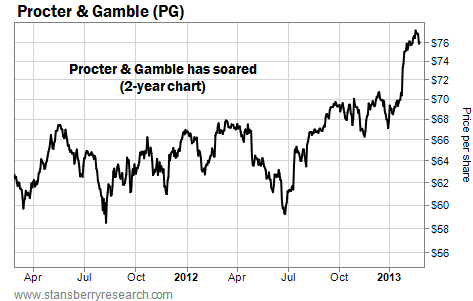| Home | About Us | Resources | Archive | Free Reports | Market Window |
A Hidden Source of Double-Digit Annual ReturnsBy
Wednesday, February 27, 2013
If you're looking to earn 10% or more on your portfolio year after year, chances are, you're looking in the wrong place...
Chances are, you're buying risky, overpriced, "high growth" stocks that have a good story. Or you're buying risky, leveraged, "high income" stocks. Either way, over the long term, you're more likely to lose money than make it.
Most companies that are growing fast command much too high a premium in the market. If the growth comes in below expectations, you lose big. And most companies that pay double-digit yields are vulnerable to even small potholes in the credit or commodity markets.
Here's the thing: You're missing one of the world's greatest sources of double-digit annual returns. It's right under everyone's nose. But hardly anyone sees it.
Let me show you what I mean...
Over the long term, big dividend growth usually comes with big share-price growth...
Think about it... A higher dividend makes the shares more valuable.
Think about a company that pays $0.50 in annual dividends. If the share price is $20, that's a 2.5% yield. Now let's say the company increases its dividend payout to $0.55. For the yield to stay at 2.5%, the share price would have to climb to $22.
So all things being equal, a 10% increase in the dividend payout will translate into a 10% increase in share price. (Adding in the original dividend, you've made 12.5% in a year.)
But I've found that over the long term, companies that regularly make large increases to their dividends see large long-term share price growth as well.
Take Wal-Mart (NYSE: WMT) for example. Since March 1974, the retail giant's split-adjusted dividend has grown about 24.4% a year, and its split-adjusted share price has grown about 24% a year. That's incredible.
Of course, the math doesn't always work out so perfectly. I first recommended Wal-Mart to my readers in 2006. Over that time, its share price is up 46%. Its dividend is up an incredible 180%.
Even when the numbers don't line up exactly, big dividend growth and big share-price growth move together.
McDonald's split-adjusted dividend has grown about 21% per year since 1976. Its split-adjusted share price has grown about 13% a year. Yes, the McDonald's numbers are different... But they're both enormous, especially when you stop to realize you're talking about 37 years of compounding.
Medical equipment manufacturer Becton-Dickinson is another example. Becton-Dickinson's split-adjusted dividend has grown about 13% a year since 1992. Its split-adjusted share price has grown about 14% a year.
The point isn't that share price and dividend growth are exactly the same over time. It's that when one of them grows a lot over the long term, the other grows a lot, too.
When dividends rise decade after decade at inflation-beating rates, you can expect the value of that growth to be reflected in the share price.
In other words, when a high-quality company – like Wal-Mart, McDonald's, or Becton-Dickinson – raises its dividends by double digits every year, you can expect to average double-digit returns over the long term. And you'll do it without the risks you take on with almost every other strategy.
Most investors look for companies with high current yields or high rates of revenue growth. I look for steady, high rates of dividend growth.
For the safest double-digit long-term returns, you should, too.
Good investing,
Dan Ferris
Further Reading:
Market NotesA REVIEW OF OUR DIVIDEND FORECAST Today's chart shows how our dividend "momentum trade" forecast is playing out as expected...
Over the past few years, we've stressed the importance of dividends and high-quality stocks dozens of times in DailyWealth. In a world full of risk and fraud, getting paid steady and growing dividends is one of the market's best strategies. You can read a few of our best pieces on the idea here, here, and here.
In January 2012, we forecasted more and more investors would recognize the safety and income-producing power of dividend-payers. With interest rates so low, we knew it would become the fashionable thing on Wall Street for fund managers to say, "I own blue-chip dividend-payers." We expected this would send a flood of new money into dividend-payers like Wal-Mart and Procter & Gamble... and create a "momentum trade."
The chart below shows that this trade is playing out. It displays the past two years' trading in elite, dividend-payer Procter & Gamble (NYSE: PG). Shares have soared from $62 to $76 in the past year or so (a huge move for a blue chip). Other dividend-payers like Wal-Mart, Johnson & Johnson, and Pfizer have also soared. The flood of new money has arrived.
– Brian Hunt
 |
In The Daily Crux
Recent Articles
|


